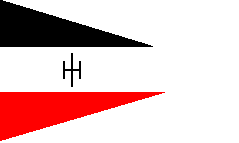|
Officers (or officials with officer-equivalent
rank) and Generals had authorized rank pennants; until April 1941, this pennant was as
shown at right; a grey pennant with white border and national emblem. In April 1941,
generals received their own pennant, with a more elaborate gold border replacing the white
border, and a gold eagle replacing the white eagle.
Command
pennants were carried on the left (driver) side of the vehicle, and officer pennants on
the right (passenger) side.
The pennants were covered with cloth covers when the officer
was not actually using the vehicle.
Units of battalion, regiment or brigade size were designated by
a flag bearing the Waffenfarbe, or arm of service colour, associated with that unit.
In a division, infantry units would have used white, artillery red,
signals lemon yellow, pioneers black, reconnaissance golden yellow, etc.
| Harkos The
term Harko (Höherer Artillerie Kommadeur - Higher Artillery Commander) designated both an
officer and a headquarters unit that co-ordinated all the artillery units within an
Army. The pennant at right, authorized in October 1943, was used to designate
these officers/units. |
 |
|
| Panzer Groups During the invasion of France, two formations named for their
commanders, Panzer Group von Kleist and Panzer Group Guderian, wore capital letters
denoting these designations on their vehicles as an additional form of
identification. After the invasion of Russia, other formations sometimes wore
similar unofficial markings.
Panzer Groups were again designated for Barbarossa; Panzer
Groups were eventually designated Panzer Armies. |
G |
K |
|
| Number Plates German soft-skin vehicles and armoured cars or APCs were given
individual number plates, at first painted on metal signs and attached, but increasingly
painted on the vehicle itself as the war progressed. The plates were white, being
rectangular on the front of vehicles and square on the rear, sometimes with two used on
front and/or rear instead of a single plate. Motorcycles had smaller plates, with
the front plate being curved to fit the contour of the fender. Numbers were issued
from a series, and a prefix identified the branch of service. Unit identification was
often indicated by the use of a Feldpost stamp on the plate, bearing the unique numerical
designator for that unit as assigned by the army post office. These numbers were
assigned at battalion and sometimes company/battery/squadron level. |
| WH |
Wehrmacht
- Heer |
| WL |
Wehrmacht
- Luftwaffe |
 |
Waffen
SS |
|
Vehicle Numbers
As an aid to operating in formation, a system of vehicle
numbers was developed for German tanks (that was also used on armoured cars, armoured
personnel carriers and self-propelled weapons). These numbers were painted on turret
and hull sides, in the main, and the style of numbers used changed throughout the war.
In general, the system involved use of 3 digits numbers; the
first digit indicating the Company the tank belonged to, the second the Platoon, and the
third the vehicle's position within the platoon. Some panzer divisions and units
used variations, such as one or two digit numbers, specifying only individual tanks or
platoon/tank combinations.
A typical tank company would thus appear as:
| THIRD
COMPANY |
1st Vehicle |
2nd Vehicle |
3rd Vehicle |
4th Vehicle |
5th Vehicle |
| First Platoon |
311 |
312 |
313 |
314 |
315 |
| Second Platoon |
321 |
322 |
323 |
324 |
325 |
| Third Platoon |
331 |
332 |
333 |
334 |
335 |
| Fourth Platoon |
341 |
342 |
343 |
344 |
345 |
Company command vehicles would have a second
digit of 0 to indicate headquarters.
Battalion command vehicles would have a Roman numeral
designating the battalion. The commander of the first battalion of a panzer regiment
might thus have tank I 01. The second battalion commander would have II 01, etc. Other
officers were designated with higher numbers; in general vehicle 02 designated the
executive officer, 03 the signals officer and 04 the ordnance officer of that battalion.
Regimental command vehicles had an R instead of the Roman
numeral to indicate a staff vehicle. R01 was the regiment commander, R02 the
executive officer, R03 the regimental signals officer, and higher numbers designated other
staff officers.
Some battalions and regiments used non standard
numbers. Other units avoided the use of the R, as it gave away the status of
the officer commanding the tank. Instead, "fake" company numbers,
referring to companies that did not exist in a panzer regiment (for example, the 9th
company) were used, as was the number 0 (ie 001, 002, etc.)
Divisional and Regimental Markings
The unit listing pages on this site will show the divisional
markings carried on unit vehicles; some regiments adopted special markings also
(especially panzer regiments), and independent units like heavy tank battalions or Assault
Gun detachments also wore special insignia. These markings could be found on all
manner of vehicles, including tanks, halftracks, trucks, motorcycles, even horse drawn
field kitchens were found to be marked with divisional markings. |

